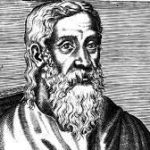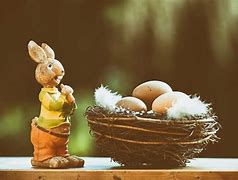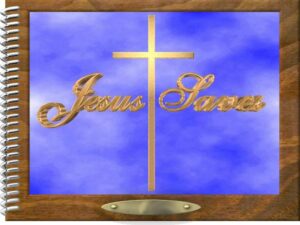Have you ever wondered what a bunny that lays eggs has to do with Easter? Do bunnies even lay eggs? How did the bunny and the egg theory ever come into being? How did Easter come about? What are its origins? These are some of the questions we will look at in today’s article.
Bunnies, chickens, and colored eggs all have to do with the Easter Tradition. Today we want to know what do eggs and bunnies have in common. Why isn’t the chicken laying the colored eggs?
Easter was not always a religious holiday but actually had its roots in pagan lore and legend. It was not until 325 A.D. that the Nicean Council declared it a religious holiday.
In order to understand the symbols of Easter, we must go back to its early history.
According to Legend, there was always an early spring festival celebrating the end of winter and the beginning of Spring. This festival was held at the time of the first full moon following the vernal equinox. A fertility goddess named Estre was the goddess of offspring and springtime.
Many pagan religions held the same festival but with different names for their fertility goddess. She was known as Ishtar, Ashtoreth (mentioned in the Old Testament), and Eostre. Besides the difference in names, the similarities suggest the same goddess.
She was the goddess of fertility. It was believed by Babylonian legend that a giant egg fell from heaven and was incubated by doves. This is how Ashtoreth/Ishtar/Eastre was born. The god of fertility was called Baal, or Bel in the Celtic tongue.
The egg is an earthly symbol of the god of fertility. The hare is associated with the goddess. Together we have male god and female goddess to bring on the season of fertility.
The egg symbolizes the beginning of life, the germination of life. Gifts of colored eggs were often given to celebrate the coming of spring.
It is not surprising to find the hare as a symbol of fertility. The hare is a nocturnal creature and is actually a little different from the cottontail rabbits that we have associated Easter with today.
What is the difference between hares and rabbits? Well, as already mentioned hares are nocturnal. Hares are also born with their fur and their eyes wide open. They are ready to hop right away. Bunnies on the other hand are born with no hair and blind. They must stay with the mother until they are weaned. Bunnies run, hares hop. As rabbits are seen more readily than hares, the rabbit became the symbol for Easter.
Rabbits begin reproducing between the ages of 3 and 5 months of age. The gestation period is 28 days (a lunar cycle) and the litter can be from 3-9 bunnies with the average being 4 per litter.
Bunnies are prolific breeders so we see how they are so easily integrated into the springtime celebration of Eastre.
The legend is told that Eastre had a beautiful, large bird. One day she magically changed it into a hare and that is why it makes a nest and fills it with eggs.
The Easter bunny was first mentioned in Germany in the 1500s.
Eggs, as mentioned earlier, were a symbol of rebirth. They were given to each other to celebrate the arrival of spring. The egg represents fertility, purity and rebirth.
It is believed that eggs make a man more virile. We can see why eggs would be such a mainstay in the fertility festival.
There is an old legend that you can stand an egg on its end during the spring equinox. This apparently has to do with the force of the sun on that particular day. It has been proven that this is not so. You can stand an egg on end any day of the year. It is not the force of the sun but the skill of the person standing the egg that has merit.
It is also interesting to note that eggs were used to cure the “evil eye”. The evil eye was a curse that was believed to dry up all living things. It was said to wither trees, dry up milking animals and nursing mothers, etc. The cure always involved using an egg to withdraw the curse.
So we can see now how we got the Easter Rabbit and colored eggs.
One more thing I would like to look at is the tradition of eating ham at Easter and how the festival of Eastre and Easter came together.
According to The Encyclopedia of Religion, 1987 “Easter” “It was a popular Easter custom amongst Europeans and Americans to eat ham at Easter, because the pig was considered a symbol of luck in pre-Christian European culture.”
German tradition believed that pigs are symbols of luck. If you had a pig to feed your family you were considered lucky, because times were hard.
(This luck of the pig is probably one of the reasons that people keep their money in piggy banks.)
According to Legend, Nimrod, one of Noah’s descendants, married his mother and became a great king. After his death, his wife/mother proclaimed he had become a “sun god” and was to be called Baal. He was worshipped as a god of fertility and promoted sexual sin. Ishtar (his wife/mother) eventually became pregnant with her son Tammuz who was killed by a pig. She ruled that because her son was killed by a pig, the pig must be eaten on this particular Sunday.
It is interesting to note that swine are not eaten by those of the Jewish faith. It was an abomination of God to eat. The Passover was celebrated with eating lamb which symbolizes their redemption. Some may say that eating ham at Easter is an abomination of the Christian religion.
Problems arose because the festival of Eastre and the Christian observance of celebrating the Resurrection of Jesus fell at the same time of year. Pagans did not like the idea of Christianity because it was too solemn a religion. The early church felt that if it borrowed some of the pagan symbols and icons and make them part of the Christian celebration, this would help the pagans to turn to Christianity more easily. The change was a good way to ease converts from paganism to Christianity.
Because the celebration of Eastre and the celebration of the Resurrection of Jesus fell at the same time of year the Nicean Council declared that the day would be celebrated on the first full moon after the vernal equinox and would be called Easter, instead of Eastre.
And that my friends is how Easter was created.














More Stories